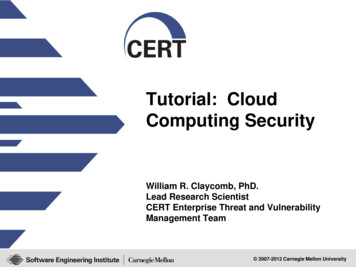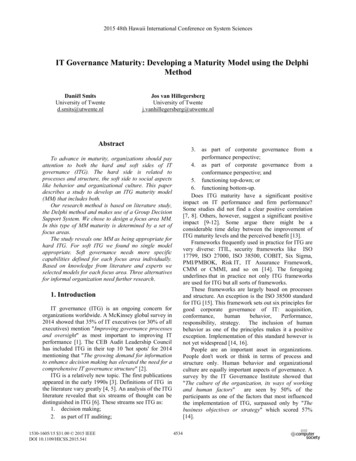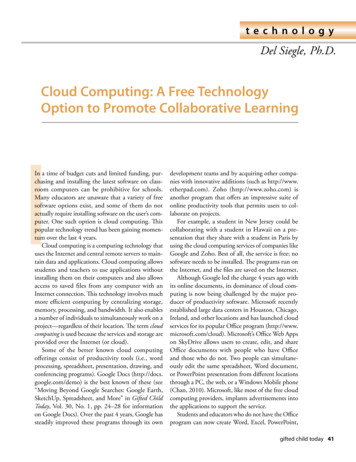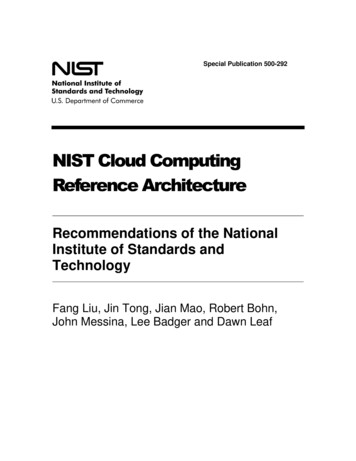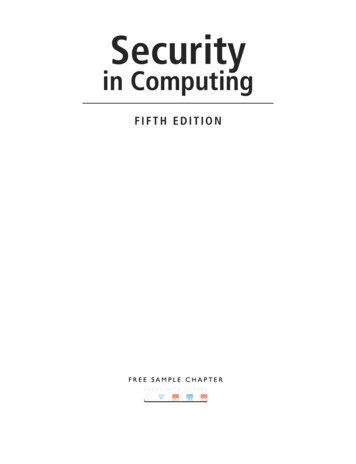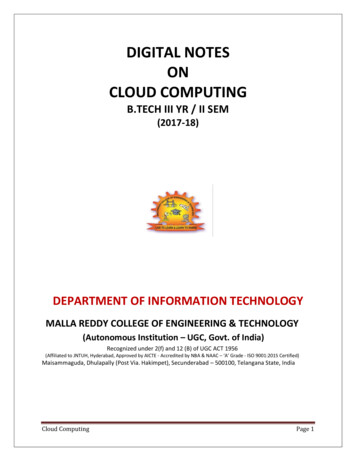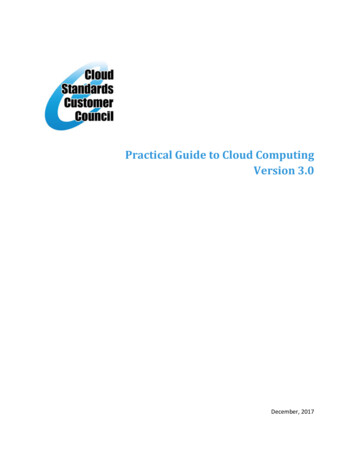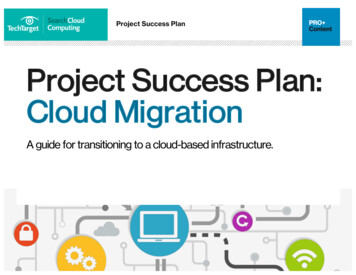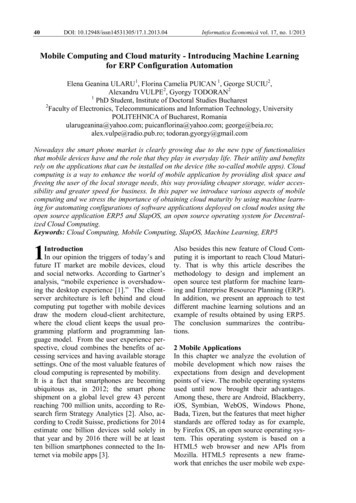
Transcription
40DOI: 10.12948/issn14531305/17.1.2013.04Informatica Economică vol. 17, no. 1/2013Mobile Computing and Cloud maturity - Introducing Machine Learningfor ERP Configuration AutomationElena Geanina ULARU1, Florina Camelia PUICAN 1, George SUCIU2,Alexandru VULPE2, Gyorgy TODORAN21PhD Student, Institute of Doctoral Studies Bucharest2Faculty of Electronics, Telecommunications and Information Technology, UniversityPOLITEHNICA of Bucharest, Romaniaularugeanina@yahoo.com; puicanflorina@yahoo.com; george@beia.ro;alex.vulpe@radio.pub.ro; todoran.gyorgy@gmail.comNowadays the smart phone market is clearly growing due to the new type of functionalitiesthat mobile devices have and the role that they play in everyday life. Their utility and benefitsrely on the applications that can be installed on the device (the so-called mobile apps). Cloudcomputing is a way to enhance the world of mobile application by providing disk space andfreeing the user of the local storage needs, this way providing cheaper storage, wider accessibility and greater speed for business. In this paper we introduce various aspects of mobilecomputing and we stress the importance of obtaining cloud maturity by using machine learning for automating configurations of software applications deployed on cloud nodes using theopen source application ERP5 and SlapOS, an open source operating system for Decentralized Cloud Computing.Keywords: Cloud Computing, Mobile Computing, SlapOS, Machine Learning, ERP51IntroductionIn our opinion the triggers of today’s andfuture IT market are mobile devices, cloudand social networks. According to Gartner’sanalysis, “mobile experience is overshadowing the desktop experience [1].” The clientserver architecture is left behind and cloudcomputing put together with mobile devicesdraw the modern cloud-client architecture,where the cloud client keeps the usual programming platform and programming language model. From the user experience perspective, cloud combines the benefits of accessing services and having available storagesettings. One of the most valuable features ofcloud computing is represented by mobility.It is a fact that smartphones are becomingubiquitous as, in 2012; the smart phoneshipment on a global level grew 43 percentreaching 700 million units, according to Research firm Strategy Analytics [2]. Also, according to Credit Suisse, predictions for 2014estimate one billion devices sold solely inthat year and by 2016 there will be at leastten billion smartphones connected to the Internet via mobile apps [3].Also besides this new feature of Cloud Computing it is important to reach Cloud Maturity. That is why this article describes themethodology to design and implement anopen source test platform for machine learning and Enterprise Resource Planning (ERP).In addition, we present an approach to testdifferent machine learning solutions and anexample of results obtained by using ERP5.The conclusion summarizes the contributions.2 Mobile ApplicationsIn this chapter we analyze the evolution ofmobile development which now raises theexpectations from design and developmentpoints of view. The mobile operating systemsused until now brought their advantages.Among these, there are Android, Blackberry,iOS, Symbian, WebOS, Windows Phone,Bada, Tizen, but the features that meet higherstandards are offered today as for example,by Firefox OS, an open source operating system. This operating system is based on aHTML5 web browser and new APIs fromMozilla. HTML5 represents a new framework that enriches the user mobile web expe-
41Informatica Economică vol. 17, no. 1/2013rience across devices. It represents an intelligent usage of less code to optimize web applications. Users expect to access the published content through a wide range of platforms with a minimum engaged complexity[4].The mobile evolution from the usual consumer applications to more complex enterprise applications goes toward a single toolthat matches all the mobile applications. Anissue raised by the content of applications isrepresented by the request to develop different renditions based on various features ofthe devices. A common approach would beto have applications built upon open standards, but there is reluctance towards adoptingopen applications. Native applications offer apackage of content and services and theypermanently verify what it occurs on theirown platforms. These applications put a barrier on what HTML5 web applications areable to accomplish from the technical pointof view and business motives. However,HTML5 is not able to adjust to all the features of mobile devices and it is also incapable of replacing on its own what native applications can offer.Table 1 shows a parallel comparison betweenHTML5 usage and native applications whichwould emphasize aspects such as the benefitsof the latter:Table 1. Native Applications vs. HTML5Native applicationsHTML5Full package of in-applicationsReaches cross platformsand adsEncompasses fast and cheap developCamerament capabilitiesLibraryDiscoverable research engineAddress bookProvides local storage of dataMarketing through applicationUsage of less code to optimize web apstoreplicationsHTML5 also has disadvantages such as thelack of push messaging, access to camera, library, and address book and there is no distribution available in application stores. Mobile web applications target clients eager toexplore and native applications create a relationship with clients based on fidelity.Overall, HTML5 represents an appreciatedway of creating valuable mobile applications.The cross platform tools used for development in mobile applications are centralizedon a cloud. The cloud is the platform that allows customers and developers to build andconceive mobile applications. This platformallows the optimization of the services, encompasses analytics and it holds push notifications.Environments for mobile applications are offered .e.g. by Brightcove App Cloud and Application Craft [5]. These allow end users tocustomize the applications built usingHTML5 in order to be used on different mo-bile operating systems. Brightcove AppCloud is used by developers to even build native applications for iOS and Android. On themarket, there is already a competition forcross-platform development tools, the abovementioned platforms being compared withPhoneGap platform [5].Once the applications are developed and released there is the need of maintenance andfurther optimization. Brightcove App Cloudenables the support for the whole cycle ofmobile applications, on different platforms.App Cloud puts together the native blockswith HTML5 in order for the users to be ableto build up, customize and visually designapplicationswithoutprogrammingknowledge. After the publishing of an application, App Cloud is able to maintain an ongoing optimization in order to enrich the enduser experience. All the development toolsavailable, in combination with Cloud func-
42tionalities make the entire development process of mobile applications easier.App Cloud relies on open standards such asHTML5, JavaScript and CSS3, so the need toknow particular programming languages, asfor example Java for Android is not necessary. It allows using templates to build different applications. The changes and customizations done for the mobile application arein real-time and they are immediately pushedto the end-users. Using open standards andlimiting the complexity of application development, smaller organizations can becomecapable of launching mobile applications, sothe extensive coverage of large organizationsis reduced.Another API alternative for building mobileapplications that access the native functionalities of the devices is Apache Cordova. Developing with this API requires the usage ofHTML, CSS and JavaScript, without havingto use native code, such as C or Java. ApacheCordova’s Javascript libraries can be deployed on iOS, Blackberrry, Android, Windows Phone, WebOS, Symbian and Bada sothe cross-platform consistency representsagain an advantage.3 Storage for Mobile ApplicationsMobile applications come with the advantageof data portability. Nevertheless, sometimes,it might happen that the connection to the Internet is not available and this is the crucialmoment when mobile web applications areaffected. The evolution of mobile development has reached the point where web applications may work offline, without the connection to a network.One of the reasons why native applicationsheld the monopoly on web applications is thelocal storage. The operating system of the native applications comes with a layer that allows the storage of data in XML files, INIfiles or registry, sometimes being possibleeven to include separate databases as long asthe platforms permit.When analyzing the objectives of web development, we observed that one of them wasthe data storage on the client side, at first using the HTTP cookies, where the local stor-Informatica Economică vol. 17, no. 1/2013age of data was possible for a limit of 4KB ofdata. Among the drawbacks of storing data assuch was the fact that at each HTTP call,cookies were attached, which leads to situations where data was sent insecure over andover again, unless the web application ranover a SSL (secure sockets layers) connection. SSL is a protocol that ensures a protected communication over the Internet. For amobile web application to be able to work offline it is necessary to hold large amounts ofdata on the client side, data that remainsavailable after the page is refreshed andwhich may or may not be sent to the server.Offline web applications are based on datafrom HTTP received from the servers. Wheneverything needed to display a page is cached(Javascript, HTML, CSS files), the web pages are loading fast. For offline applications itis imperiously necessary to have everythingcached by the browsers. When resources arecached, while the network connection is lost,the web pages are not loaded from the servers; they are accessed from local storage.When connectivity to a network is regained,the cached memory is compared to see ifthere are any new items. If the items werechanged then they are automatically downloaded and uploaded. This way web application are becoming more accessible to users,due to the fact that the time spent for loadingpages is reduced by the local storage of thedata that was usually retrieved each timefrom the serversNowadays, HTML5 browsers allow the replacement of data in structured key-value local storage. The key-value stored data has alimit size with limits measured in Megabytes,not in Kilobytes as it is the case with cookies.The storage is of two types: local storage andsession storage. The server loading side isreplaced by client-side usage through clientside scripts that permit local storage of datain a JavaScript database, where data is manipulated using SQL [6].A JavaScript database class, based onSQLite, provides a relational database intended for local storage of content that is toolarge to conveniently store in cookies (or istoo important to risk accidentally deleting
43Informatica Economică vol. 17, no. 1/2013when the user clears out his or her cookies)[19].Storage on different mobile device platformsis available by using for example CordovaAPI [7].Web databases are supported by Opera Mobile, Safari Mobile and Chrome for Androidweb browsers. The databases can be createdby APIs, and they can also be opened andclosed via APIs. There are some essentialmethods used to manipulate data for mobiledatabases: openDatabase, transaction andexecutesql [19].In order to create database the openDatabasemethod is used and the output is a Databaseobject, built through a SQLite Database. TheDatabase object is further used in order tomanage data. This database is created on theHTML page and its population is not done asusual via data input. The supported platformsare Android, iPhone, Android, WebOs andTizen. The method has arguments, such asdatabase version,database name,data-etc. Seethe following example, where a Database object is obtain from the call of window.openDatabase method [8]:base displayname, database sizeVardatabase window.openDatabase(“trial”, “1.0”, “New Database”, 2000)The objects used by Cordova nd localStorage. The local storage is notintended for the storage of a large amount ofdata. For localStorage objects, there aremethods defined such as localStorage.keyaimed to have as output an index,localStorage.getItem - to identify a valueoftheparticularargument,localStorage.setItem – keeps the argumentand the value, localStorage.removeItem –deletes the value of the particular argumentand localStorage.clear - deletes the content storage from localStorage. [8]The disk space for the databases should bedefined by the users and there should be implemented warnings for quota limits. Also,the permission to modify the space usedshould be available. When using Opera, thedatabase is created without a quota warningfor the database size. Nevertheless, in Safarithe user receives a warning if the created database has a size higher than the default size,which is 5 MB.After we assessed the evolution of mobiledevelopment and the advantages of using thelatest technologies we can conclude that flexibility is easier than ever to be gained. Mobile applications are becoming more interactive and display their content in a more efficient way. [9] Now applications are availablein offline mode due to local storage and userscan access information despite the missingnetwork connectivity. This is all possible dueto the offline databases concept withinHTML5 from the client side perspective.4 Mobile Cloud and the EnterpriseUsually new technologies are first adoptedby big enterprises and after this adoption,they come to the masses. This is the way ithappened with cloud computing. It was developed as a concept in order to improvebusiness activity and after that it was extended to the personal use. Nowadays you canhave your space in the cloud where you storeyour files by using different cloud serviceproviders. The situation is different with mobile devices. At the beginning, mobile devices were used to access applications and alsoinformation in the cloud but nowadays theyare extended to the enterprise as a way of doing business on the move.As we previously mentioned we considermobile devices and cloud technology themain drivers for the new IT market, especially on the business level and mobility is themain factor leading to our beliefs.The definition provided by the Mobile CloudComputing Forum [10] considers mobilecomputing as referring to “an infrastructurewhere both the data storage and the data processing happen outside of the mobile device.Mobile cloud applications move the computing power and data storage away from mobile phones and into the cloud, bringing applications and mobile computing to not justsmart phone users but a much broader rangeof mobile subscribers”.Cloud computing can be defined as “a solu-
44Informatica Economică vol. 17, no. 1/2013tion that provides new ways of using externalresources that you can configure according toyour needs - servers, storage, applicationsand services. A great economical advantageis that resources are leased by the Cloud provider on-demand and in variable quantities sothat the client only pays what he consumes. In other words, if you do not use theresources, you do not pay it.”[11] The characteristics comprised in this definition together with the portability and flexibility ofmobile devices creates the possibility totransform any enterprise to an enterprise inmotion. The motion is represented by the enterprise’s connectivity to every employee,customer and partner in a fast and cost effective manner. What we have observed duringthis study is that because the mobile deviceswere firstly designed for personal use there islittle extension to the enterprise level. Thecloud today doesn’t take explicitly into consideration mobile applications. That is whyimportant changes have to be made in orderto ease mobile computing adoption.Fig. 1. Including Mobile computing in the EnterpriseAt the beginnings of Cloud Computing therewas stress on the importance of standards inorder to survive as a technology not only abuzz word and so these standards were developed step by step as a sign of market maturity. In our opinion this maturity wasreached too early due to the ongoing potential of cloud technology. This potential wasdemonstrated by the need to integrate mobilecomputing. The existing standards, althoughnot unified, do not support mobile computingthus they need to be rethought.In order to successfully adopt mobile computing, companies need to align their BusinessStrategy and Enterprise Architecture to thenew technology.As we can see in Figure 1, in order to add anew idea to the strategy plan, like movingtowards mobile computing you need to havean enterprise architecture that allows systems, processes and infrastructure to be readyfor the change.5 Cloud Computing and the EnterpriseWe consider Mobile computing as the futureand an innovation to cloud computing but wedo realize the importance of Cloud as the basis for every other development. That is whythis article takes also Machine Learning andData Mining in the cloud into considerationas a step towards cloud maturity.Once a company uses an open source systemin the cloud to manage everyday information,it is important to learn how to use such information to help with decisions which haveto be made. Creating good reports thanks toMachine Learning and Data Mining tools is avery important aspect of the ERP/CRM/DMSsystems. Here we introduce the open sourcesoftware ERP5 and compare it with differentopen source solutions for machine learningand data mining.We will introduce in this article SlapOS, anopen source operating system for Decentralized Cloud Computing. SlapOS is based on
Informatica Economică vol. 17, no. 1/2013the following daemons: buildout – to buildany application from source code or binarieslocated in package repositories, supervisord –to monitor and control the processes of theinstantiated software and, finally, slapgrid,that implements the decentralized cloud protocol and accounting functions. [12]. SlapOSis based on a master-slave architecture,where the master has the scheduling and accounting role, thus sending status requestsand collecting process resource usage fromslave nodes. The SlapOS kernel is built onthe ERP5 cloud engine model to handle thebilling and resource optimization. SLAPstands for “Simple Language for Accountingand Provisioning”.This structure has been implemented forcloud-based automation of ERP and Customer Relationship Management (CRM) software for small and medium enterprises(SMEs) and aspects are under developmentunder the framework of the European research project “Cloud Consulting” [13].ERP systems are at the core point of a SMEsmanagement and reporting activities. AlsoSMEs can compete with large enterprises byemploying similar technologies in the cloud,that have been available only for organizations that could afford paying consulting services and maintaining such costly infrastructures [14].Here we use the answers provided by a ChiefExecutive Officer (CEO) of a SMB in theform of a questionnaire and deploy MachineLearning and Data Mining methodologies toautomatically generate an initial basic configuration. The initial configuration is applied to the ERP5 system that is hosted asSoftware as a Service (SaaS) on a public orprivate cloud. Furthermore, the configurationcan be refined by human IT consultants, andresult in a functional configuration. In [13]the authors have presented the applicabilityof these approaches to automate ERP configuration for SMEs and use open source distributed cloud systems for hosting this typeof web-based application.This approach will significantly reduce timeand cost of ERP implementation for SMEs.A CEO of a small business can spend just45one hour of his time to answer twenty or thirty questions resulting in a made-to-measureERP to meet most explicit and implicit requirements of his company.Also in this paper we present a first prototypeapplication of machine learning for configuring an ERP. This technological breakthroughwas not possible before the advent of CloudComputing and SaaS. In previous approachesERPs were implemented by consultants, inmost cases on a local server. No companycould aggregate enough ERP user cases toconsider automating the configuration process and providing the necessary resilience[15].6 Machine Learning Analyses and MethodologyThe current research is based on a designscience approach [16] that has its origins inengineering, and can be considered a problem solving approach aiming to create innovative and useful IT artifacts. The followingIT artifacts can be defined: Constructs (vocabulary and symbols), Models (abstractions and representations), Methods (algorithms and practices), Instantiations (implemented and prototype systems).In our project we use the latter three artifactsand an instantiation (a prototype) is considered to be the final outcome. Design-scienceresearch can be based on explicit frameworkswhich provide a set of guidelines for conducting and evaluating good design-scienceresearch.We use the SlapOS platform implementedduring the “Cloud Consulting” project [13]hosted on several servers running UbuntuLinux – Apache – MySQL with current software release. On our cloud testing environment we provide the platform for the installation of thousands of different companies, enabling the analysis of ERP usage datathrough a large sample of companies.In the case of our research the most important input artifacts are SlapOS and the underlying ERP5 and the data mining tools offered by Rapid-I [14]. All were assessed as
46Informatica Economică vol. 17, no. 1/2013suited. Within the overall design science project other research methods are embedded.These are expert interviews to capture humanconfiguration knowledge, multiple case studies to feed the data mining parts with configuration data and to assess the outcome of theautomatic configuration, prototyping to testfor technical feasibility in detail. This makesour technological approach applicable also toautomated provisioning of cloud services[17] and ready to be disseminated muchquicker.First step will be modeling an enterprisebased on a collection of questions, possiblyseveral hundred questions. These questionswill be the basis for the development of expert knowledge and machine learning models. They will also be used to collect sampledata for the data mining approach.Next step will be creating knowledge engineering technologies and models based onexplicit rules which do not require preexisting sample data and which can producea rough configuration. Such models will beused to reduce the number of questions anSME CEO will need to answer, and to generate default configuration values and we alsouse data mining to optimize rules.Third step is creating machine learning models based on data mining with sample datawhich can be used to optimize the models.Also, some statistical models can be generated to improve the CEOs’ replies by analyzingthe evolution of the ERP configuration.7 Automation Procedure and InformationSourcesTo follow the steps described in the methodology, data is gathered from different information sources that belong to differentknowledge domains, as show in Figure 2[18].Fig. 2. Proposed automation procedureBy using the flexible database structure ofERP5, where tables can be configured andadded to the catalog without the need to interrupt the data warehouse, we can reconfig-ure the system structure according to the configuration values.The accepted configuration values have asorigin the knowledge and assumptions about
Informatica Economică vol. 17, no. 1/2013the current ERP system. The effect of the automated configuration options are analyzedand tested, so that the conclusions of the automation can be applied also to similar configuration scenarios [18].The following information sources are considered when making assumptions about theconfiguration options: Textbooks and academic publications, Industry standards and reference models, Expert knowledge, including activity reports of developers and consultants whoimplement the ERP systems, Previous implementation projects, including configuration values and documentation, Documentation, such as design and architectural documents, technical and implementation documents, user manual Source code and screen shotsThe most difficult information source togather is the expert knowledge on categoryimplementation [18]. This can be done by: Conducting and initial interview with experts on the various components of theERP system, Questionnaire to be completed by expertstakeholders so that the initial assumptions can be verified against the prototypeimplementation, Knowledge generated by the automationprocedure itself, Interactions with ERP implementationstakeholders, such as developers, testersand consultants.Based on the information gathering, analysisand assumptions, one of the available automation approaches is selected and the ERPconfiguration is automatically implementedin the form of a first prototype.Furthermore, the initial questionnaires can beused to validate and verify the assumptionson which the prototype is implemented.478 Automation ApproachesWe consider two approaches to automate theconfiguration of categories that are based onartificial intelligence algorithms.The first approach is based on knowledgeengineering and defines a decision tree thatmodels the rules for the categories which willbe configured.The second approach is following a machinelearning model where a set of answers and aset of categories are used as training data fora classifier.As a common point, both approaches arebuilding an expert system where answers to alist of questions are stored. Based on this initial data the category configurations are generated.The disadvantage of knowledge engineeringapproach is the scaling of the decision tree,which must be manually defined by an ERPimplementation expert with the aid of aknowledge engineering expert. This requiresknowledge about the specific ERP system,the technical configuration parameters andoptions. Also the mapping of the differentbusiness requirements to the configurationcategories is impossible to be done for allconfiguration cases. The configuration casessupported by the decision tree have thereforeto be narrowed, as seen in Figure 3 [18].On the other side, the machine learning approach has the problem of automatic category configuration that can be treated as a classification problem. The problem can be considered similar to the problem of text classification where a document has to be classified into categories, and solved such as classifying email into categories “Spam” and“Not Spam”. The documents to be classifiedin this automation approach are sets of answers to a questionnaire. Likewise, a Pythonscript can be used to classify a textual description of the business activity of a company to a set of product line categories [18].
48Informatica Economică vol. 17, no. 1/2013Fig. 3. Decision tree design tool developed in ERP5The script we first developed in Python defines a list of questions, which are describedby the following fields: id: the internal identifier of the question, title: the question as it is displayed to theuser in the questionnaire system, values: a list of possible answers, includ-ing also previously corrected answers, type: either “selection” (only a single answer is accepted) or “multiple selection”(multiple answers are accepted).In our example four questions are defined inthe question list:{’id’ : ’manufacturing’,’title’ : ’Are you a manufacturing organization?’,’values’ : (’y’, ’n’),’type’ : ’selection’,}, # might influence: role, function, activity, publication section{’id’ : ’manufacture-what’,’title’ : ’What do you manufacture?’,’values’ : (’products’, ’spare parts’,),’type’ : ’multiple selection’,}, # might influence: product line, activity, function{’id’ : ’manufacture-how’,’title’ : ’How do you manufacture your products ?’,’values’ : (’oem’, ’factory’, ’outsource’, ’other’,),’type’ : ’multiple selection’,}, # might influence: role, publication section{’id’ : ’supplier-types’,’title’ : ’What types of suppliers do you have?’,’values’ : (’business’, ’not-for-profit’,),’type’ : ’multiple selection’,}, # might influence: role, publication section, product line, activity
49Informatica Economică vol. 17, no. 1/2013It is useful to add a commentary at the end ofeach question that is a rough assumption ofwhich categories could be influenced by therespective question [18]. The initial trainingdata in our prototype consists of four examples, each defined by an id, a set of answersand a set of assigned categories, for example:{ ’id’: ’Beia Consult � : ’n’,’manufacture-what’ : (’products’),’manufacture-how’ : (’factory’,’other’),’supplier-types’ : ��role/salesprospect’,]},In Figure 4 we show the question management tool we developed in ERP5 design toolfor company Beia Consult. The web interfaceallows creating and collecting the differenttypes of configuration questions, such asstring (free text, multiple answers) or booleanquestions.Fig. 4. Question management tool for machine learningThe questionnaire results show the main advantage of this approach, that it can be usedwhere few training data is available. Furthermore, to be more flexible for new configuration cases, a predictive engine can beenvisioned for suggesting new answer values, if none of the predefined answers fits forthe selected industry. The questionnaire system allows also storing the history and reviewing the different versions of th
HTML5 is not able to adjust to all the fea-tures of mobile devices and it is also incapa-ble of replacing on its own what native appli-cations can offer. Table 1 shows a parallel comparison between HTML5 usage and native applications which would emphasize aspects such as the benefits of the latter


